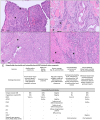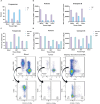Case report: Characterization of the immunologic and molecular landscape in a unique presentation of invasive lobular carcinoma with concurrent uterine carcinosarcoma treated with immunotherapy
- PMID: 39076998
- PMCID: PMC11284112
- DOI: 10.3389/fimmu.2024.1422342
Case report: Characterization of the immunologic and molecular landscape in a unique presentation of invasive lobular carcinoma with concurrent uterine carcinosarcoma treated with immunotherapy
Abstract
Invasive lobular breast cancer (ILC) is characterized by a relatively high risk for late recurrence and a unique metastatic pattern with an increased risk for metastasis to gynecologic organs and peritoneum. We present a unique case of recurrent ILC with metastasis to the abdominal peritoneum as well as the uterine myometrium and cervix. Treatment was complicated by the discovery of concomitant uterine carcinosarcoma. This patient was effectively treated with a combination of hormonal therapy for her metastatic ILC and a combination of chemotherapy and immunotherapy for uterine carcinosarcoma. Molecular evaluation revealed a characteristic CDH1 mutation within the ILC and a PI3KCA mutation within the uterine carcinosarcoma, both of which have been linked to epithelial-to-mesenchymal transitions. Examination of the tumor immune microenvironment revealed proportionally more cytotoxic NK cells. This robust immune infiltration may be an indicator of the response to immunotherapy observed in this tumor or a result of the metastatic breast cancer within the uterus. This report provides a characterization of the molecular and immunologic landscape in this case with metastatic ILC and uterine carcinosarcoma.
Keywords: NK cell (NKC); carcinosarcoma; epithelial to mesenchymal (EMT); immunotherapy; lobular breast cancer.
Copyright © 2024 Riedinger, Eisele, Esnakula, Stover, Freud and Cosgrove.
Conflict of interest statement
The authors declare that the research was conducted in the absence of any commercial or financial relationships that could be construed as a potential conflict of interest.
Figures



References
-
- Pestalozzi BC, Zahrieh D, Mallon E, Gusterson BA, Price KN, Gelber RD, et al. . Distinct clinical and prognostic features of infiltrating lobular carcinoma of the breast: combined results of 15 International Breast Cancer Study Group clinical trials. J Clin Oncol. (2008) 26:3006–14. doi: 10.1200/JCO.2007.14.9336 - DOI - PubMed
-
- Borst MJ, Ingold JA. Metastatic patterns of invasive lobular versus invasive ductal carcinoma of the breast. Surgery. (1993) 114:637–41;discussion 641-2. - PubMed
Publication types
MeSH terms
Substances
LinkOut - more resources
Full Text Sources
Medical
Miscellaneous

